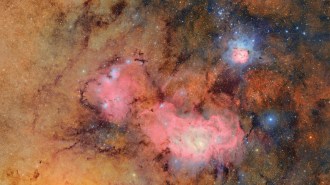Atom & Cosmos
Long-lost Martian glaciers, ozone on Venus and more in this week's news
Enceladus: Me 2 maybe! RT @Europa I have a global ocean!
Add another candidate to the roster of sloshy outer solar system moons with global oceans. Joining water world Europa is the moon-of-the-moment: Enceladus, the tiny Saturnian satellite best known for spewing saltwater into space from large fractures known as “tiger stripes.” But, raked across the south pole, the fractures aren’t quite parallel — and scientists now blame a lurking global ocean and free-floating icy canvas for their different orientations. In a study to appear in Geophysical Research Letters, scientists from the University of Idaho in Moscow describe a rotating crust topping a global sea. Though a liquid pocket on Enceladus is widely accepted, scientists are still debating whether the moon hosts a global ocean or regional sea. —Nadia Drake
Go-go-glacier
Four billion years ago, visitors to Mars might have gone glacier-skating in the north. Scientists now think that an ancient, glacier-ringed northern ocean explains some of Mars’ strange geology. In the southern highlands, hydrated minerals litter depressions, valleys, and impact craters, but they’re missing from the flat, northern lowlands. Early Martian temperatures varied enough to allow a frozen, northern ocean and a warmer, liquid tropical ocean to coexist, an international team of scientists reports online August 28 in Nature Geoscience. Ice sheets surrounding the frigid sea prevented aqueous minerals from trickling into the flatlands and slowed mineral formation. —Nadia Drake
Venusian ozone discovered
For the first time, astronomers have detected ozone on Venus. The molecules were spotted in the upper atmosphere on the planet’s nightside by the European Space Agency’s Venus Express spacecraft. The concentrations match what’s expected to arise from chemical processes involving chlorine, just as on Earth, but the amount of Venusian ozone is far lower than Earth’s. Because levels of ozone and ordinary oxygen molecules are closely linked, studying ozone on Venus could help researchers spot signals of habitability or even life on alien worlds, an international team reports in an upcoming Icarus. —Camille M. Carlisle
Black hole twins
Astronomers have spotted two madly gobbling black holes in a spiral galaxy’s core. The black holes are each cocooned by clouds and blaze a quadrillion times brighter in X-rays than the sun does because of the energy produced by their eating. Black hole pairs have been seen before in merging galaxies, and also in roundish elliptical galaxies, but this duo is the first spotted in a spiral galaxy, researchers at the Harvard-Smithsonian Center for Astrophysics in Cambridge, Mass., report online August 31 in Nature. The new observations suggest that the spiral merged with a smaller galaxy, aiding astronomers’ efforts to understand galaxy and black hole coevolution.—Camille M. Carlisle
Bizarre star
Astronomers have discovered a chemically primitive star that challenges standard views about how stars are born. Theory suggests that stars less than 0.8 times the sun’s mass can’t form until enough old stars explode to enrich the nearby space with elements heavier than helium. But a star dubbed SDSS J102915+172927 turns out to exist in a part of the Milky Way’s halo that doesn’t have these heavier elements, and so the star too is made almost entirely of hydrogen and helium. Primitive stars can thus form in places scientists didn’t expect them to, Elisabetta Caffau of the Center for Astronomy of Heidelberg University consortium and the Paris Observatory writes with her colleagues in the Sept. 1 Nature. —Alexandra Witze







